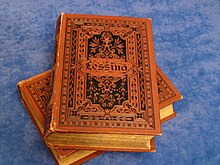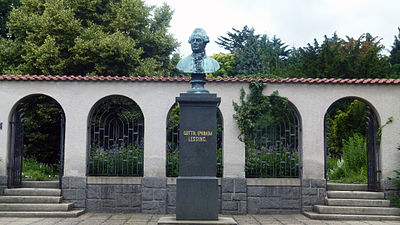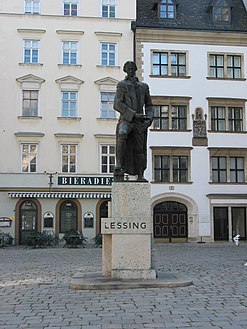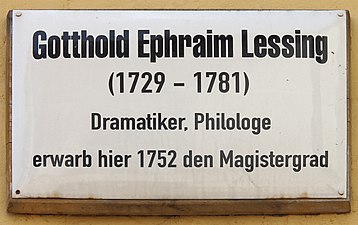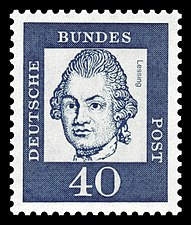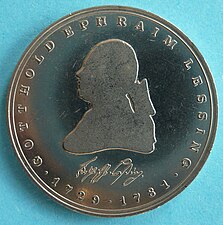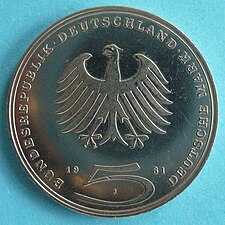Gotthold Ephraim Lessing

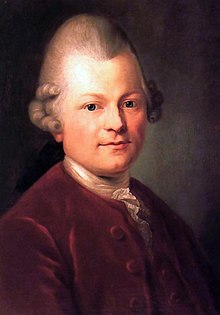
Gotthold Ephraim Lessing (born January 22, 1729 in Kamenz , Markgraftum Oberlausitz , † February 15, 1781 in Braunschweig ) was an important poet of the German Enlightenment . With his dramas and his theoretical writings, which are primarily committed to the notion of tolerance , this enlightener has shown the further development of theater a significant path and has had a lasting impact on the public impact of literature . Lessing is the first German playwrightwhose work is continuously performed in theaters to this day.
Life
origin
Gotthold Ephraim Lessing was the third child and the second eldest son of the Kamenz archdeacon Johann Gottfried Lessing and his wife Justina Salome (née Feller) (1703–1777). Nine siblings followed over the years, but only seven of his siblings survived their first day of life, so that Gotthold was ultimately the eldest son. On January 24th, 1729 he was baptized in the St. Marienkirche in Kamenz by his grandfather Gottfried Feller.
The father Johann Gottfried Lessing was a representative of the Lutheran orthodoxy . With the Lessings, who were already in the second generation of the city's elite, the Bible, belief and concern for the material “daily bread” dominated the conversation while eating.
school
Lessing's father initially taught his son himself in order to prepare him for school and university. At the age of five Lessing was able to read the Bible and the catechism formulated by his father . He then got the private teacher Christlob Mylius at his side, with whom he remained on friendly terms even after his studies.
When their ways parted due to the teacher's departure, his father sent him to the public Latin school . There it quickly became apparent that Lessing had a quick grasp of his age and was a clever child. When the teaching of the Latin school was no longer sufficient for the intellectual abilities of the pupil, Lessing's father submitted a request to the elector in 1737 to accept his son Gotthold Ephraim as an “ alumnus with a free boarding post” in the Princely School of St. Afra in Meißen . In 1741 he passed the entrance exam in St. Afra with flying colors and thus fulfilled the expectations placed on him by his father.
Equipped with a scholarship from the von Carlowitz family, he switched to the Princely School in Meißen on June 22, 1741, where, after initial conflicts with the school rules, he fitted into the institutional life and, in addition to the extensive curriculum of the school in the ancient languages Latin, Greek and Hebrew found little time to deal with contemporary “beautiful literature”, even German or modern magazines. Lessing's first attempts at writing date back to this time. In 1746 Lessing was prematurely dismissed by the rector Theophilus Grabener because of his excellent achievements.
Education
Lessing went to study at the University of Leipzig and matriculated on September 20, 1746. He initially studied theology at the request of his father, but soon lost interest in it and began, under the influence of his friend Mylius, to the sorrow of his parents, with poetry and theater to deal with.
In 1748 he switched to medical studies and on August 20 of the same year went to further studies at the University of Wittenberg . In November 1748, after having recovered from illness, he moved to the Brandenburg capital of Berlin. There he reviewed the Berlinerische Privilegierte Zeitung (later the Vossische Zeitung ), in 1750 worked for the Critical News from the Realm of Scholarship and met Voltaire in 1750, among others .
From 1751 Lessing concentrated on his studies in Wittenberg. As a medical student, he pursued a degree at the philosophical faculty. There he had lectures by Johann Heinrich Martius in poetics, Martin Hassen in ethics, by Johann Daniel Ritter in history, by Georg Wilhelm Kirchmaier in Greek language and literature, by Karl Gottlob Sperbach in philosophy, by Georg Friedrich Baermann and Johann Friedrich Weidler in Mathematics, by Georg Matthias Bose in physics and by Johann Wilhelm von Berger in rhetoric. As a medical student, Georg August Langguth , Abraham Vater , Daniel Wilhelm Triller and Georg Rudolf Böhmer were his teachers. Educated in this way, Lessing completed his doctorate in the Magister of the Seven Liberal Arts on April 29, 1752, probably with a thesis on the Spanish doctor and philosopher Juan Huarte .
Berlin

When Lessing returned to Berlin in November 1752, he moved into an apartment with Christian Nicolaus Naumann . He made the acquaintance of Karl Wilhelm Ramler , Friedrich Nicolai , Ewald Christian von Kleist , Johann Georg Sulzer , Carl Philipp Emanuel Bach and became friends with Moses Mendelssohn .
In October 1755 he returned to Leipzig. In the following year he planned an educational trip through the Netherlands, England and France over several years as the companion of the Leipzig merchant's son Christian Gottfried Winkler (1731–1795), which he and Winkler in particular had to break off in Amsterdam because of the Seven Years' War . In the same year he met Johann Wilhelm Gleim , Friedrich Gottlieb Klopstock and Conrad Ekhof .
In 1758 Lessing moved to Berlin again, where he and Friedrich Nicolai and Moses Mendelssohn published the letters concerning the latest literature . In 1760 Lessing was elected a foreign member of the Berlin Academy of Sciences .
Breslau and Hamburg
From 1760 to 1765 he was employed in Breslau as a secretary for General Tauentzien . In 1765 he returned to Berlin.
In 1767 Lessing went to the Hamburg National Theater as a dramaturge and consultant for three years , of which Abel Seyler was the main supporter . The theater was closed again for financial reasons in 1769, when Seyler had spent all his fortune. Lessing's play Minna von Barnhelm was performed in the theater . During his work at the Hamburg theater he made the acquaintance of Friedrich Ludwig Schröder , Carl Philipp Emanuel Bach , Johann Melchior Goeze , Johann Friedrich Löwen and the Reimarus and König families. During this time he met his future wife Eva König , whose husband Engelbert König was still alive at the time.
Librarian in Wolfenbüttel, wedding
In Wolfenbüttel he became a librarian in the Herzog August Library on May 7, 1770 . There he discovered the high medieval work Schedula diversarum artium by Theophilus Presbyter , which he published in 1774 under the title Vom Alter der Ölmalerey from Theophilus Presbyter .
On October 14, 1771 Lessing was accepted into the Masonic lodge Zu den Drei Rosen in Hamburg , in a modified ceremony in the apartment of the lodge master von Rosenberg, and introduced to all three degrees . He was a member until 1780, but never visited the lodge again. He valued the idea of Freemasonry, as can be seen in his work Ernst and Falk , published in 1778 and 1780, but not real Freemasonry as it was then shown.
In 1771 he became engaged to Eva König, who was widowed in 1769 . In 1775 his work in the library was interrupted by several trips to Eva König's respective whereabouts, to Vienna via Leipzig, Berlin, Dresden and Prague and an audience with Emperor Joseph II. As a companion of the Brunswick Prince Leopold he traveled to Italy with stays in Milan, Venice, Florence, Genoa, Turin, Rome, Naples and Corsica.
On October 8, 1776, he and Eva König married in Jork near Hamburg in the house of Johannes Schuback . On Christmas Eve 1777 she gave birth to her son Traugott, who died the following day. On January 10, 1778 Eva Lessing also died of puerperal fever .
death

In 1779 Lessing's health deteriorated. At the end of January 1781, the poet, plagued by asthma attacks, caught a cold while driving from Wolfenbüttel to Braunschweig in icy temperatures. On February 3, he collapsed in the apartment of his host, assistant and confidante Samson Alexander David . Lessing had campaigned with the authorities for the release of this young Jewish businessman from prison, where the son of the prominent and wealthy court chamber agent Alexander David had been after a lottery fraud affair. On February 15, 1781 between eight and nine o'clock in the evening Lessing died in the arms of Simson Alexander David immediately after a phlebotomy of dropsy in the house of the Brunswick wine merchant Angott, where the poet kept an apartment. Lessing is said to have been excited about current church politics right up to the last breath. The occasion was the suggestion of the Jülich clergy to physically punish negligent churchgoers, which outraged the poet. Eyewitness David wrote about Lessing's hour of death: “He died as he lived: As a wise man, determined, calm, full of reflection until the last moment.” Church papers were upset by the fact that a Jew was present at Lessing's deathbed. In Braunschweig, Lessing's numerous opponents spread hateful rumors that Lessing's death cost the Duke 361 thalers an advance, which can be written off. The Hamburg authorities forbade any kind of obituary and poems of praise.
Lessing was buried in the Braunschweig Magnifriedhof . In 1793 the Braunschweig publisher Johann Heinrich Campe set him a simple stone with Lessing's name and the date of birth and death. His grave was thought to be lost and was found again in 1833 by the Braunschweig private scholar and art historian Carl Schiller .
Today's tomb with a relief portrait of Lessing was not erected until 1874. It was executed in the studio of the court sculptor Theodor Strümpell based on a design by Friedrich Lilly . It was donated by the directorship of the Ducal Court Theater with the approval of Duke Wilhelm .
Act
Lessing was a versatile poet, thinker and critic. As a leading representative of the German Enlightenment, he became a pioneer for the new self-confidence of the bourgeoisie . His theoretical and critical writings are characterized by an often witty and ironic style and accurate polemics . The stylistic device of the dialogue met his intention to always look at a matter from several sides and also to look for traces of truth in the arguments of his counterpart. This never appeared to him as something solid that one could own, but always as a process of approaching.
The idea of freedom - for the theater against the dominance of the French model, for religion by the dogma of the church - runs like a red thread through his whole life. Logically, he also campaigned for the liberation of the aspiring bourgeoisie from the patronage of the nobility. In his own literary existence, he also always strived for independence. His ideal of a life as a freelance writer was difficult to enforce against economic constraints. In Hamburg, for example, the “Deutsches Museum” project that he tried to carry out in 1768 with Johann Christoph Bode failed .
The dream of the theater
In his theoretical and critical writings on theater and his own dramatic work, he tried to contribute to the development of a new bourgeois theater in Germany. He turned against the dominant literary theory of Gottscheds and his students. Above all, he criticized the mere imitation of the French models and played Shakespeare against Corneille and Racine (see 17th literary letter). It was Lessing who established the reception of Shakespeare in Germany in the first place. In his tragic poetic writings (correspondence about the tragedy, Hamburg Dramaturgy), he pleaded for a return to the classic principles of Aristotle 's poetics , but changed the Aristotelian doctrine of the tragic affects of pity and fear (eleos and phobos) by deriving pity declared to be the decisive tragic affect. In his own tragedy he took up the Attic tragedy, in particular the motif of delusion, which brought about the downfall of his tragic heroines (Sara Sampson, Emilia Galotti) and his tragic hero (Philotas). He worked with several theater groups (e.g. with Friederike Caroline Neuber ).
His own work seems to us today like the prototypes for the later developed bourgeois German drama. Miss Sara Sampson is considered to be the first German-language bourgeois tragedy , Minna von Barnhelm as a model for many classic German comedies , and Nathan the Wise as the first ideological drama . His theoretical writings Laokoon and Hamburgische Dramaturgie set standards for the discussion of aesthetic and literary theoretical principles. In his search for a German-speaking bourgeois theater, Lessing was strongly influenced by the intellectual influence of the French encyclopedist and philosopher Denis Diderot . In his Le Fils naturel ou les Épreuves de la vertu, comédie suivie des Entretiens sur le Fils naturel (1757), he saw Fils naturel for short , which he translated into the German language (“The natural son, or the samples of virtue Model ”) a literary model for his Nathan the Wise (1779). Lessing valued Diderot's theater reform, especially because of the abolition of the class clause , the abolition of the heroism of the dramatic characters and the use of prosaic language in the drama.
The critic and enlightener
In his writings on the philosophy of religion, Lessing argued against belief in Revelation and against adherence to the "letters" of the Bible by the prevailing doctrinal opinion. On the other hand, he trusted in a "Christianity of reason" that was based on the spirit of religion. He believed that human reason , triggered by criticism and contradiction, would develop without the help of divine revelation. In order to stimulate a public discussion against the orthodox "adherence to letters", he published seven fragments of an unnamed in the years 1774 to 1778 , which led to the so-called fragment dispute. His main opponent in this dispute was the Hamburg chief pastor Johann Melchior Goeze , against whom Lessing published writings by Hermann Samuel Reimarus called anti-Goeze .
In addition, in the numerous arguments with the representatives of the prevailing doctrinal opinion (e.g. also in the Anti-Goeze ) he advocated tolerance towards other world religions . He also implemented this attitude dramatically in the drama Nathan the Wise , when he was banned from further theoretical publications. In the pamphlet The Education of the Human Race, he presented his position coherently. Inspired by Jean de La Fontaine , he also devoted himself to the animal fable , which he, however, re-enlightened and metaphysically revised: for example, in his fable The Raven and the Fox, flattery is not used rewarded as in the original form of the story, but severely punished with the aim of a more just moral.
Lessing and the publishing industry
In Lessing's time, book manufacturers such as those of Johann Friedrich Cotta , Friedrich Nicolai or the Dieterich'sche Verlagbuchhandlung became centers of the German Enlightenment; However, as a result of the accompanying commercialization of the literary business, it became more and more important for many authors as well as for Lessing himself to secure income from the sale of their books in addition to (often poorly paid) court offices. In this context, he unsuccessfully campaigned for a reorganization of the publishing industry and a fair distribution of the income from the use of the authors' intellectual property as well as the prevention of pirated prints , which could hardly be prevented by official interference because of the small German states.
Works (selection)
Poems
- The three kingdoms of nature (1747)
- Little things (first printed in 1751)
- Songs. [Edition 1771]
- Odes. [Edition 1771]
- Epistles. [Edition 1771]
Fables
- Fables and tales. [Edition 1772]
- Fables. Drey books : In addition to treatises with content related to this type of poetry. [Edition 1759] ( digitized version and full text in the German text archive )
- Fables. [Gleanings]
Dramas
- Damon, or true friendship (comedy), 1747
- The young scholar (comedy), 1747
- The old maid (comedy), written in 1748, published in 1749
- The Misogyn (comedy), written in 1748, published in 1755
- The Free Spirit (comedy), 1749
- The Jews (comedy), 1749
- The treasure (comedy), 1750
- Miss Sara Sampson (Tragedy), 1755
- Philotas (tragedy), 1759
- Minna von Barnhelm (comedy), 1767
- Emilia Galotti (Tragedy), 1772
- Nathan the Wise (Dramatic Poem), 1779
Drama Fragments
Aesthetic fonts
- Reviews
- Letters
- Prefaces
- The Lord of Voltaire's Minor Historical Writings
- GE Lessing's writings. First part
- GE Lessing's writings. third part
- Gotth. Ephr. Lessing's Theatrical Library
- Mixed writings of Mr. Christlob Mylius
- Gleim, Prussian war songs
- Friedrich von Logau's epithets
- Mr. Diderot's theater
- Treatises of the whiny or touching comedy
- Reflections on the whiny comic
- Prof. Gellert's treatise for the touching comedy
- About the comedy "The Jews"
- A vade mecum for Mr. Sam Gotthl. Long . Pastor in Laublingen
- Rescues of Horace
- Correspondence about the tragedy
- Treatises [on the fable]
- Letters concerning the latest literature
- Laocoon or Beyond the Limits of Painting and Poetry
- Hamburg Dramaturgy ( digitized version and full text in the German text archive, vol. 1, digitalized version and full text in the German text archive, vol. 2)
- The reviewer doesn't need to be able to do better ...
- How the ancients formed death (1769) Archive.org
- Live and let live
- Self-contemplations and ideas
- Editor's Opposites
Theology-critical and philosophical writings
- Thoughts about the Moravians
- The Christianity of Reason
- Pope a metaphysician!
- About the origin of the revealed religion
- About the reality of things other than God
- Through Spinoza, Leibniz is only ...
- A parable
- Anti-Goeze
- Ernst and Falk
- That there can be more than five senses for man
- Conversations about the soldiers and monks
- The religion of Christ
- The education of the human race ( digitized and full text in the German text archive )
- FH Jacobi on his conversations with Lessing
- A duplicate
Expenditure:
- Works and letters. 12 volumes in 14 sub-volumes. Edited by Wilfried Barner . Berlin 2003. ISBN 978-3-618-61053-3
- Honor has never sought me. Poems, letters, critical writings, plays. Märkischer poet garden. Edited by Gerhard Wolf . Berlin 1985
Portraits & busts
- unknown artist, portrait of old age, oil on canvas, around 1780, ( online , Lessing-Museum, Kamenz)
- Johann Heinrich Tischbein the Elder Ä. , Portrait, oil on canvas, 46 × 35 cm, around 1740, ( online , Nationalgalerie Berlin)
- Ernst Friedrich Bussler (1773–1840) after Johann Heinrich Tischbein the Elder. Ä., Etching, dotted manner, 145 × 117 mm (representation, oval), 226 × 148 mm (plate), 246 × 166 mm (sheet), around 1800. Staatliche Kunstsammlung Dresden, Kupferstich-Kabinett, inventory number: A 1995-10462 , ( online , SKD).
- Anton Graff (1736–1813), portrait, oil on canvas. 56.5 × 47 cm bust, red skirt with vest of the same color, lace jabot, wig.
- Friedrich Müller (1749–1825) after Anton Graff, portrait, copper engraving, 14.9 × 18.6 cm, ( online , Winckelmann Museum Stendal)
- Lazarus Gottlieb Sichling (1812–1863), half-length portrait to the right, steel engraving after Anton Graff around 1840 Kupferstich-Kabinett, inventory number: A 1995-10424, dimensions: 142 × 118 mm (illustration without framing); 254 x 211 mm (plate); 375 × 282 mm (sheet), ( online , SKD)
- probably Barbara Anna Rosina Lisiewska (1713–1783), portrait, oil on canvas, 78.6 × 64.6 cm, around 1767–1768 ( online , Gleimhaus Halberstadt, portrait collection, friendship stamp)
- Christian Friedrich Krull , bust, height 38.4 cm, around 1780.
- Ernst Rietschel , bust. Material and technology: plaster, dimensions: H. with base: 64 cm, W: 41.5 cm, D: 30.0 cm, around 1848 (dating refers to the original), sculpture collection: Staatliche Kunstsammlung Dresden, inventory number: ASN 0068, ( online , SKD).
- Ernst Rietschel, colossal statue, material and technology: plaster, dimensions: H (with plinth): 280.0 cm, W: 115.0 cm, D: 107.0 cm, around 1848/49 (dating refers to the original) , Sculpture collection: Staatliche Kunstsammlung Dresden, inventory number: ASN 4700, ( online , SKD).
- Adolf Neumann: Portrait (3/4 figure, standing), wood engraving, inscribed: A. NEUMANN .XA, in: Die Gartenlaube. Illustrated family sheet. Born in 1879. Ernst Keil, Leipzig 1879, p. 5.
Honors
Museums
- Berlin
The Lessing Museum in Berlin existed from 1905 to 1936. It was founded by Georg Richard Kruse , a composer, music writer and autograph collector, together with like-minded people. The museum was intended to celebrate the writer on the one hand and to popularize his thoughts on tolerance between Christians and Jews on the other. The exhibition rooms were opened in 1905 at Lessing's former residence at Königsgraben 10. In 1910 the museum had to give way to a branch of the Tietz department store and move to the Nicolaihaus, Brüderstraße 13. For a time the museum also became the seat of the Lessing University with Kruse as its director (1913/14). With the support of the family and sponsors, including Jews and Freemasons, the Lessing Museum was able to acquire many personal items by Lessing and those around him over the years. After the takeover of the Nazis , the museum was closed in 1936. The valuable exhibits were offered and sold to other museums.
- Kamenz
The museum in his hometown of Kamenz not only traces Lessing's life, but also links his biography with theater history through theater models, stage designs and costumes.
- Wolfenbüttel
Today a museum with 15 exhibition rooms in the Lessinghaus Wolfenbüttel provides information about Lessing's life. The Lessing Academy , also located in Wolfenbüttel, was founded in 1971 and is dedicated to Lessing's work and the Age of Enlightenment.
Monuments (selection)
In honor of Lessing, numerous monuments were erected, especially in the 19th and early 20th centuries.
Equestrian statue of Frederick the Great (1851). From left:
Count von Finckenstein , Schlabrendorf , Count von Carmer (with book), Graun (with piano roll), Lessing and KantUnveiling of the monument on Hamburg's Gänsemarkt (1881)
- On the equestrian statue of Frederick the Great in Berlin ( Unter den Linden ) Lessing is one of 74 portrayed contemporaries of Frederick the Great . The monument was designed by Christian Daniel Rauch and unveiled on May 31, 1851 after several years of construction.
- The bronze statue on Lessingplatz in Braunschweig was based on a design by Ernst Rietschel . The face was designed by Christian Friedrich Krull after a portrait bust by Lessing. The memorial made by Georg Ferdinand Howaldt was unveiled on September 20, 1853.
- The Lessing memorial created by the sculptor Hermann Knaur was erected in Kamenz in 1863 on the occasion of the inauguration of a Lessing memorial .
- Lessing monument in Hamburg on the Gänsemarkt (1881).
- The Lessing memorial in Berlin's Tiergarten (Lennéstraße) was created by Lessing's great-great-nephew Otto Lessing and unveiled on October 14, 1890. The bronze portraits on the base show the publisher and writer Friedrich Nicolai, the poet Ewald von Kleist and the writer, philosopher and entrepreneur Moses Mendelssohn.
- The Lessing memorial created by Siegfried Charoux is located on Judenplatz in downtown Vienna . The original was completed in 1931/32, unveiled in 1935 and demolished and melted down by the National Socialists in 1939. From 1962 to 1965 Charoux created a second Lessing monument made of bronze, which was unveiled in 1968 on Ruprechtsplatz and moved to Judenplatz in 1981.
- In Wolfenbüttel, a relief image created by Friedrich Wilhelm Eugen Döll in the ducal library and the Nathan the Wise monument from 1961 remind of Lessing. The latter comes from the sculptor Erich Schmidtbochum . The actor Ernst Deutsch sat as a model.
Other monuments:
- The Lessing Bridge in Berlin-Moabit , designed by Ludwig Hoffmann and opened in 1903, showed four bronze reliefs depicting the final scenes of the dramas Miss Sara Sampson , Emilia Galotti , Nathan the Wise and Minna von Barnhelm . The reliefs by August Jäkel , reassembled in 1983 , are replicas of the originals by Otto Lessing, which were melted down during the Second World War.
- Baron Otto August von Grote erected a monument in the park of his Breese estate in 1781 (now Gut Wrestedt / Uelzen).
- The Lessing memorial in Frankfurt am Main was designed by Gustav Kaupert on behalf of the Jewish citizen of Frankfurt, Herz Hayum Goldschmidt , and erected in front of the former city library in 1882. It has been in the Obermain facility since 1961.
Locations
In over 1000 cities and towns, streets, paths and squares were named after Lessing:
- 1102 times " Lessingstrasse "
- 74 times "Lessingweg"
- 15 times " Lessingplatz "
- 4 times "Lessingring"
- 2 times each "Lessingbrücke" and "Lessingallee"
- depending once Lessing path Lessinggasse, Lessinggäßchen, Lessing Berg, Lessing dirt road and Lessing tunnel
Memorial plaques
- The memorial plaque donated by the city of Berlin in 1913 at Nikolaikirchplatz 7 in Berlin-Mitte commemorates the completion of Minna von Barnhelm's work in 1765.
- A memorial plaque in Wittenberg reminds of Lessing's studies in Lutherstadt.
- In Kamenz a plaque reminds of the former location of the house where he was born.
Prices
Several Lessing Prizes have been donated in Lessing's honor:
- Lessing Prize of the GDR
- Lessing Prize from the Free and Hanseatic City of Hamburg
- Lessing Prize of the Free State of Saxony
- Lessing Prize for Criticism
- Lessing ring of the German Freemasons
- Lessing translator award
- Lessing on German postage stamps and coins
40 Pf permanent stamp of the Deutsche Bundespost (1961) from the series Important Germans
5 DM commemorative coin of the Federal Republic of Germany from 1981 ( obverse )
5 DM commemorative coin of the Federal Republic of Germany from 1981 ( reverse )
schools
Several schools were named after Lessing , see Lessing School .
theatre
Others
After Lessing and after his two great-nephews, the doctor and botanist Christian Friedrich Lessing and after the painter Karl Friedrich Lessing , the plant genus is Lessingia Cham. named from the sunflower family (Asteraceae).
Some houses in different places also bear his name.
literature
- current
- Wilfried Barner , Gunter E. Grimm, Helmut Kiesel, Martin Kramer: Lessing. Epoch - work - effect. 5., rework. Edition CH Beck, Munich 1987, ISBN 3-406-32065-1 . 6th edition, CH Beck, Munich 1998, ISBN 3-406-43221-2 .
- Wilfried Barner: Lessing, Gotthold Ephraim. In: New German Biography (NDB). Volume 14, Duncker & Humblot, Berlin 1985, ISBN 3-428-00195-8 , pp. 339-346 ( digitized version ).
- Cord-Friedrich Berghahn: "Sounds in music are not signs". Lessing and the music. Lessing Academy, Wolfenbüttel 2012, ISBN 978-3-942675-16-1 .
- Gerd Biegel , Heidi Beutin , Wolfgang Beutin, Angela Klein (eds.): "Lovers of Theology". Gotthold Ephraim Lessing - philosopher - historian of religion. Braunschweig contributions to cultural history. Volume 3. Peter Lang, Frankfurt am Main 2012, ISBN 978-3-631-57875-9
- Martin Bollacher: Lessing: reason and history. Investigations into the problem of religious enlightenment in the late writings. Tübingen 1978. Reprint Berlin 2016. ISBN 3-484-18052-8 .
- Eva J. Engel , Claus Ritterhoff (ed.): News on Lessing research. 1998, ISBN 3-484-10770-7 .
- Monika Fick : Lessing manual. Life - work - effect. 3rd, revised and expanded edition, Metzler, Stuttgart 2010, ISBN 978-3-476-02248-6 .
- Rolf Hagen : Gotthold Ephraim Lessing in Braunschweig. In: Gerd Spies (Hrsg.): Festschrift for the exhibition: Brunswiek 1031, Braunschweig 1981. The city of Heinrich the Lion from its beginnings to the present. Orphanage printing house, Braunschweig 1981, p. 636.
- Dieter Hildebrandt : Lessing. Biography of an emancipation. Munich 1982, ISBN 3-423-34049-5 .
- Hugh Barr Nisbet : Lessing. From d. Engl. By Karl S. Guthke , CH Beck, Munich 2008, ISBN 978-3-406-57710-9 .
- Hugh Barr Nisbet: Gotthold Ephraim Lessing. His life, works, and thought. Oxford Univ. Press, Oxford 2013, ISBN 978-0-19-967947-8 (English translation by Lessing. A biography. Munich 2008).
- Volker Nölle: Subjectivity and Reality in Lessing's Dramatic and Theological Work. Berlin 1977.
- Hans-Josef Olszewsky: Lessing, Gotthold Ephraim. In: Biographisch-Bibliographisches Kirchenlexikon (BBKL). Volume 4, Bautz, Herzberg 1992, ISBN 3-88309-038-7 , Sp. 1545-1551.
- Heiko Postma : "Buried under books" Gotthold Ephraim Lessing (1729–1781). From freelance writer to librarian in Wolfenbüttel . JMB, Hannover 2015, ISBN 978-3-944342-65-8 .
- Jan Philipp Reemtsma : Lessing in Hamburg: 1766–1770 , CH Beck, Munich, 2007, ISBN 978-3-406-55695-1 ( excerpts online ).
- Paul Rilla : Lessing and his age (= Beck's black series 150). 2nd, unchanged edition, CH Beck, Munich 1968, ISBN 3-406-04950-8 .
- Jürgen Schröder : Gotthold Ephraim Lessing. Language and drama. Wilhelm Fink, Munich 1972.
- Wilhelm von Sternburg : Gotthold Ephraim Lessing (= Rowohlt's monographs 50711). Rowohlt, Reinbek near Hamburg 2010, ISBN 978-3-499-50711-3 .
- Stefanie Stockhorst : Introduction to the Gotthold Ephraim Lessing plant. Scientific Book Society, Darmstadt 2011, ISBN 978-3-534-22984-0 .
- Ingrid Strohschneider-Kohrs , M. Niemeyer: Reason as wisdom. Studies on the late Lessing. (= Hermaea NF, vol. 65). Niemeyer, Tübingen 1991, ISBN 3-484-15065-3 .
- Gisbert Ter-Nedden: Lessing's tragedies. (= German Studies 57). The origin of modern drama from the spirit of criticism. Metzler Verlag, Stuttgart 1986, ISBN 3-476-00583-6 .
- Friedrich Vollhardt: Gotthold Ephraim Lessing: Epoch and Work , Göttingen: Wallstein Verlag, [2018], ISBN 978-3-8353-3328-4
- historical
- Friedrich Schlegel : About Lessing. 1797. In: Friedrich von Schlegel , Andreas Huyssen, [Hrsg.] “Athenäums” fragments and other writings (= Reclams Universal-Bibliothek . 9880). Revised and bibliographically supplemented edition, Reclam, Stuttgart 2005, ISBN 978-3-15-009880-6 , pp. 46–75.
- Franz Mehring : The Lessing legend. Dietz, Stuttgart, 1893 (International Library 17).
- Carl Christian Redlich: Lessing, Gotthold Ephraim . In: Allgemeine Deutsche Biographie (ADB). Volume 19, Duncker & Humblot, Leipzig 1884, pp. 756-802.
- Ludwig Eckardt : Lessing and the first German national theater in Hamburg. Boyes & Geisler, Hamburg, 1864, ( online ).
- Theodor Wilhelm Danzel , Gottschalk E. Guhrauer : Gotthold Ephraim Lessing: his life and works , 2,1 Gotthold Ephraim Lessing's life and works in the period of perfect maturity ; First department, Dyk, Leipzig, 1853, ( online , Bayerische Staatsbibliothek).
- Theodor Wilhelm Danzel, Gottschalk E. Guhrauer: Gotthold Ephraim Lessing: his life and his works. Dyk, Leipzig, 1850, ( online , Bayerische Staatsbibliothek).
- Rudolf Genée: The Gospel of Tolerance. A Säcular memory , in: The gazebo. Illustrated family sheet. Born in 1879. Ernst Keil, Leipzig 1879, pp. 4–8. With a portrait as a wood engraving.
Criticism from radical pietism
- Johann Daniel Müller : The victory of the truth of God's word over the lies of Wolfenbüttelschen Bibliothecarii, [Gotthold] Ephraim Lessing, and his fragment writer [that is Hermann Samuel Reimarus] in their blasphemy against Jesus Christ, his disciples, apostles, and the whole bible. 1780.
- Compare with Reinhard Breymayer : An unknown opponent of Gotthold Ephraim Lessing. The former Frankfurt concert director Johann Daniel Müller from Wissenbach / Nassau (1716 to after 1785), alchemist in the vicinity of [Johann Wolfgang] Goethe, Kabbalist , separatist chiliast , friend of the Illuminati of Avignon ("Elias / Elias Artista"). In: Dietrich Meyer (ed.): Pietism - Herrnhutertum - Awakening Movement. Festschrift for Erich Beyreuther . Köln [Pulheim-Brauweiler] and Bonn 1982 ( Series of the Association of Rhenish Church History , Volume 70), p 109-145 [to S. 108: " silhouette of [Johann] Daniel Müller"].
Web links
- Literature by and about Gotthold Ephraim Lessing in the catalog of the German National Library
- Works by and about Gotthold Ephraim Lessing in the German Digital Library
- Newspaper article about Gotthold Ephraim Lessing in the 20th century press kit of the ZBW - Leibniz Information Center for Economics .
- Works by Gotthold Ephraim Lessing at Zeno.org .
- Works by Gotthold Ephraim Lessing in Project Gutenberg ( currently not usually available for users from Germany )
- Works by Gotthold Ephraim Lessing in the Gutenberg-DE project
- Fables by Lessing in the literature network
- Gotthold Ephraim Lessing: Ernst and Falk (1776/78)
- Figure lexicon for Lessing's dramas in the online literature lexicon portal
- German education server: educational materials on Gotthold Ephraim Lessing
- Hamburg education server: German-speaking authors / Enlightenment / Gotthold Ephraim Lessing
- Annotated link collection of the university library of the FU Berlin ( Memento from July 3, 2014 in the Internet Archive ) ( Ulrich Goerdten )
- Gotthold Ephraim Lessing Biographies and Works of the University of Karlsruhe
- The poems on zgedichte.de
- Lessing Academy Wolfenbüttel
- Paul Toeche Collection - Lessingiana
- Gotthold Ephraim Lessing at arthistoricum.net - the context of the history of science and digitized works in the "History of Art History" portal
- Lectures by Gotthold Ephraim Lessing at the University of Kiel
- Gotthold Lessing from the series classic of the world literature of BR-alpha
Individual evidence
- ↑ biography. Lessing Academy , accessed on June 5, 2015 .
- ^ Genealogy of Lessing's mother, Justina Salome Lessing
- ↑ Monika Fick: Lessing manual. Life-work-effect . Metzler, 2000, ISBN 3-476-01685-4 , p. 458
- ^ Wilhelm von Sternburg: Gotthold Ephraim Lessing . Rowohlt, Reinbek 2010, ISBN 978-3-499-50711-3 , p. 22 ff.
- ^ Wilhelm von Sternburg: Gotthold Ephraim Lessing . Rowohlt, Reinbek 2010, ISBN 978-3-499-50711-3 , pp. 25-27
- ↑ Quoted from: Metzler Authors Lexicon. German-speaking poets and writers from the Middle Ages to the present . Stuttgart 1986, p. 417
- ^ A b Fritz Juntke: Album Academiae Vitebergensis. Younger series part 3, Halle (Saale), 1966, p. 274
- ↑ Heinz Kathe : The Wittenberg Philosophical Faculty 1502-1817 (= Central German Research. Volume 117). Böhlau, Cologne / Weimar / Vienna 2002, ISBN 3-412-04402-4 , pp. 455-470.
- ^ Walter Friedensburg : History of the University of Wittenberg. Max Niemeyer, Halle (Saale) 1917, p. 580
- ↑ Martin Geck: The Bach Sons , Rowohlt Taschenbuch Verlag, Reinbek bei Hamburg 2003, p. 40, ISBN 3 499 50654 8 .
- ^ Wilfried Barner: Goethe and Lessing. A difficult constellation. Wallstein Verlag, Göttingen 2001, ISBN 3-89244-408-0
- ^ CF Gellert's correspondence. Critical complete edition: CF Gellert's correspondence: 1740–1756. (Vol. 1): 1740–1755: Vol. 1 Foreword by Reynolds, John. F. Gruyter, Walter de (1988), ISBN 3-11-008409-0 , p. 415.
- ↑ biography
- ^ Eugen Lennhoff, Oskar Posner and Dieter A. Binder: International Freemasons Lexicon . 5th revised and expanded new edition, Herbig 2006, ISBN 978-3-7766-2478-6 , pp. 506-508
- ↑ Jana Cürten: Just Married 235 years ago: Lessing dared in York , in Hamburger Abendblatt , Region-Stade, November 12, 2011, ( online ).
- ^ Wikisource and NDB .
- ↑ Peter Jungblut: A demonized life. Simson Alexander David - the journalist Germany wished to hell. Berlin 2016, p. 79 ff., Also: Hugo Göring (Ed.): Lessings Werke (in twenty volumes), Vol. 1, Stuttgart, 1874, introduction p. CVII
- ^ Rolf Hagen: Lessing in Braunschweig . P. 639 (see literature).
- ↑ Gisbert Ter-Nedden: Lessing's tragedies. The origin of modern drama from the spirit of criticism . Stuttgart: Metzler Verlag, 1986 (Germanistische Abhandlungen 57). - See also the entries on Sara Sampson, Emilia Galotti and Philotas in the dictionary of figures on Lessing's dramas
- ↑ Th. C. Van Stockum: Lessing and Diderot. Neophilologus 1955, Vol. 39, No. 1, pp. 191-202
- ↑ The Theater of Mr. Diderot: The Natural Son, or the Samples of Virtue. Vol. 1 Denis Diderot, Gotthold Ephraim Lessing, Voss, Berlin 1781
- ↑ The theater of Mr. Diderot translated by Lessing, 1760, therein a. a. Le fils naturel (1757) and Le père de famille (1758); Strange example of female vengeance . Drawn from a manuscript of the late Diderot, Thalia, 1, 1785 translated by Schiller ( full text on Wikisource )
- ↑ Adam Bžoch: German Literature in the Age of Enlightenment. Catholic University in Ružomberok Press, Ružomberok, Verbum 2011, ISBN 978-80-8084-701-2 .
- ↑ Nikolas Immer; Olaf Müller: Lessing's Diderot "sweeter tears" to purify the national taste. Pp. 147-163
- ↑ See also Article Critique of Religion
- ^ GE Lessing: Live and let live (written after 1772), in; Werke Vol. 5, Munich 1973, p. 781 ff.
- ↑ Erich Schmidt : Lessing's Faust . Goethe-Jahrbuch , Volume 2 (1881), pp. 65–86: Digitized
- ↑ Gotthold Ephraim Lessing's portrait painted by Anton Graff in September 1771 in Hamburg : printed as a manuscript for friends; together with a photograph of this picture; Lecture at the Hamburg Scientific Association on February 12, 1868 by Adolph Soetbeer . - [online edition]. - Hamburg: Ackermann & Wulff, [approx. 1868], ( online , WDB).
- ↑ See Hermann Maertens: The German statue monuments of the XIX. Century . Stuttgart 1892
- ↑ Portrait bust (archive link via: Lessing Portal )
- ^ Jörg Kuhn: Otto Lessing (1846-1912). Sculptor, craftsman, painter. Life and work of an artist of late historicism with special consideration of his work as a building sculptor . Phil Diss. FU Berlin 1994.
- ^ Hans Butzmann : Lessing's monument in Wolfenbüttel . A prelude to the history of Lessing veneration, Wolfenbüttel, Herzog August Bibliothek, 1982.
- ^ Gottschalk E. Guhrauer: Gotthold Ephraim Lessing: his life and works in the period of perfect maturity. , Vol. 2. Dyk'sche Buchhandlung, Leipzig, 1854, p. 362, ( online )
- ^ Art-in-public space Frankfurt (accessed June 24, 2016)
- ^ Lessingstrasse in Germany. Streets in DE, accessed January 24, 2016 .
- ↑ Lessingstrasse 52-68 in Germany. Streets in DE, accessed January 24, 2016 .
- ^ Lessing Street in Germany. Streets in DE, accessed January 24, 2016 .
- ^ Lessing Street in Germany. Streets in DE, accessed January 24, 2016 .
- ^ Lessingweg in Germany. Streets in DE, accessed January 24, 2016 .
- ^ Lessingplatz in Germany. Streets in DE, accessed January 24, 2016 .
- ↑ Lessing ring in Germany. Streets in DE, accessed January 24, 2016 .
- ^ Lessing Bridge in Germany. Streets in DE, accessed January 24, 2016 .
- ↑ Lessing Allee in Germany. Streets in DE, accessed January 24, 2016 .
- ^ Lessing tunnel in Germany. Streets in DE, accessed January 24, 2016 .
- ↑ Lotte Burkhardt: Directory of eponymous plant names . Extended Edition. Botanic Garden and Botanical Museum Berlin, Free University Berlin Berlin 2018. [1]
| personal data | |
|---|---|
| SURNAME | Lessing, Gotthold Ephraim |
| BRIEF DESCRIPTION | German poet of the Enlightenment |
| DATE OF BIRTH | January 22, 1729 |
| PLACE OF BIRTH | Kamenz |
| DATE OF DEATH | February 15, 1781 |
| Place of death | Braunschweig |







